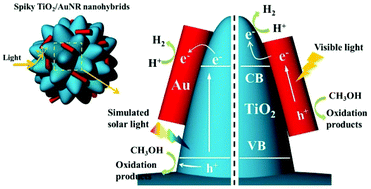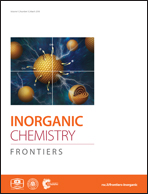Spiky nanohybrids of TiO2/Au nanorods for enhanced hydrogen evolution and photocurrent generation†
Abstract
The fabrication of photocatalysts to achieve efficient utilization of renewable solar energy has attracted broad interest. Herein, a plasmonic spiky TiO2/Au nanorod (NR) nanohybrid was prepared by in situ nucleation and growth of spiky TiO2 in AuNR colloidal solution. The spiky TiO2/AuNR nanohybrids demonstrated enhanced hydrogen evolution activity and photocurrent generation under both visible light and simulated solar light irradiation as compared to bare spiky TiO2 nanoparticles and commercial TiO2. Specifically, the spiky nanohybrids displayed a high H2 production rate of 1.81 mmol g−1 h−1 under simulated solar light irradiation, which is 1.7 times higher than that of TiO2/Au nanosphere nanohybrids, and remain stable for three cycles. The improved photocatalytic H2 evolution demonstrated by the nanohybrids can be ascribed to the coupling effect of the AuNRs and the unique spiky structure. Furthermore, the charge transfer process during H2 evolution was investigated by photocurrent and electrochemical impendence spectroscopy (EIS) measurements. A fast and stable photocurrent was observed for the spiky TiO2/AuNR nanohybrid photoelectrode under both visible light and simulated solar light irradiation, while the EIS plots indicate a rapid charge transfer within the nanohybrids. Such a nanohybrid with a bio-inspired structure will afford new insights for the fabrication of novel photocatalysts.



 Please wait while we load your content...
Please wait while we load your content...